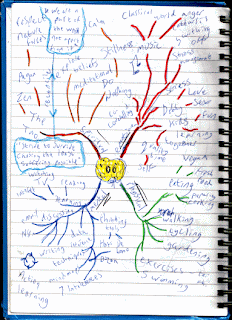Mind maps are, by definition, a graphical method of taking notes. The visual basis of them helps one to distinguish words or ideas, often with colors and symbols. They generally take a hierarchical or tree branch format, with ideas branching into their subsections. Mind maps allow for greater creativity when recording ideas and information, as well as allowing the note-taker to associate words with visual representations. Mind maps and concept maps are different in that mind maps focus on only one word or idea, whereas Concept maps connect multiple words or idea.
Mind maps (or similar concepts) have been used for centuries in learning, brainstorming, memory, visual thinking, and problem solving by educators, engineers, psychologists, and others. Some of the earliest examples of mind maps were developed by Porphyry of Tyros, a noted thinker of the 3rd century, as he graphically visualized the concept categories of Aristotle. Philosopher Ramon Llull (1235 - 1315) also used mind maps.
A mind map is a diagram used to represent words, ideas, tasks, or other items linked to and arranged around a central key word or idea. Mind maps are used to generate, visualize, structure, and classify ideas, and as an aid in study, organization, problem solving, decision making, and writing.
The elements of a given mind map are arranged intuitively according to the importance of the concepts, and are classified into groupings, branches, or areas, with the goal of representing semantic or other connections between portions of information. Mind maps may also aid recall of existing memories.
By presenting ideas in a radial, graphical, non-linear manner, mind maps encourage a brainstorming approach to planning and organizational tasks. Though the branches of a mind map represent hierarchical tree structures, their radial arrangement disrupts the prioritizing of concepts typically associated with hierarchies presented with more linear visual cues. This orientation towards brainstorming encourages users to enumerate and connect concepts without a tendency to begin within a particular conceptual framework.
The mind map can be contrasted with the similar idea of concept mapping. The former is based on radial hierarchies and tree structures denoting relationships with a central governing concept, whereas concept maps are based on connections between concepts in more diverse patterns.
Mind maps have many applications in personal, family, educational, and business situations, including notetaking, brainstorming (wherein ideas are inserted into the map radially around the center node, without the implicit prioritization that comes from hierarchy or sequential arrangements, and wherein grouping and organizing is reserved for later stages), summarizing, revising, and general clarifying of thoughts. One could listen to a lecture, for example, and take down notes using mind maps for the most important points or keywords.
One can also use mind maps as a mnemonic technique or to sort out a complicated idea. Mind maps are also promoted as a way to collaborate in color pen creativity sessions.
Mind maps can be used for:-
• Problem Solving
• Outline / Framework Design
• Anonymous collaboration.
• Marriage of words and visuals.
• Individual expression of creativity.
• Condensing material into a concise and memorable format.
• Team building or synergy creating activity.
• Enhancing work morale.

Thank you for checking out my Blog. I am a life coach,author, public speaker, group leader and free lance writer and sharing ideas is what I do. This blog contains a variety of ideas about life, spirituality and healthy, dynamic living from some of my previously published articles.I hope you enjoy my offerings. Warmest regards, Coralie aka Raia Darsey-Malloy
Popular Posts
-
By Coralie Darsey-Malloy WHY you do something is more important than HOW you do. --Dr. Robert Anthony Anyone with an once of awareness can s...
-
People say they love..something, someone, a pet, nature, their favorite "anything." That always makes me wonder what does love ...
-
By Coralie R. Darsey-Malloy Previously published in the Aquarian All rights reserved Bison meat in our cuisine is making a comeback l...
-
By Coralie Raia Darsey-Malloy Is death the final sleep? No, it is the final awakening. ---Scott For those who do not already now I am an av...
-
By Coralie Raia Darsey-Malloy Everyone wants independent choice… whatever that may cost… and wherever it may lead. --Fyodor Dostroyevsky Whe...
-
David and I generate part of our livelihood through our personal development company Fresh Beginnings...www.fresh-beginnings and we are ...
-
By CORALIE DARSEY-MALLOY The fairest thing in nature, a flower… still has its roots in earth and manure. --D.H. LAURANCE I have been " ...
-
I am a big quotations fan and add the at the beginning and end of whatever I write. They have such encapsulated wisdom and illustrate that...
Subscribe to:
Post Comments (Atom)






No comments:
Post a Comment